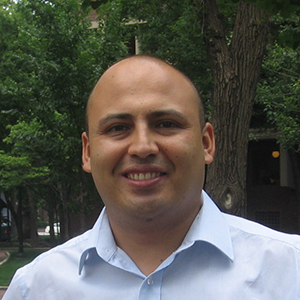Faculty

Ernesto Dal Bó
Political Economics, Influence and Corruption
Omri Even-Tov
Financial Accounting, Corporate Debt
Paul Gertler
Impact Evaluation, Public Economics
Andrea Gorbatai
Knowledge Diffusion, Information Sharing
Jose Guajardo
Operations Analytics, Operations-Marketing Interface
Terrence Hendershott
Financial Market Data, Analytics, and Trading
Przemyslaw Jeziorski
Marketing Analytics, Mobile Marketing
Zsolt Katona
Network Analytics, Social Media and Mobile Marketing
Jonathan Kolstad
Healthcare Analytics, Public Economics
Yaniv Konchitchki
Macro-Accounting, Financial Information
Ming Leung
HR Analytics, Labor Markets
Ross Levine
Financial Regulation, Entrepreneurship
Abhishek Nagaraj
Information Economics, Digital Mapping
Hoai-Luu Q. Nguyen
Consumer Credit Analysis, Banking
Panos Patatoukas
Financial Statement Analysis, Economic forecasting
Sameer B. Srivastava
Organizational Sociology, Computational Linguistics
Toby Stuart
Entrepreneurship, Innovation, Network Analysis
Mathijs de Vaan
Social Network Analysis, Economic Sociology
Johan Walden
Networks in Capital Markets
Reed Walker
Environmental Economics, Public Economics
Grants and Fellowships

The Fisher Center for Business Analytics has a limited amount of funding available for research proposals from Haas faculty members, and invites you to submit a proposal. Priority will be given to junior faculty and to proposals that are willing to share data or otherwise collaborate with other interested Haas faculty members. This year the Center seeks to award $50,000. Through the support of the Ryoichi Sasakawa Foundation, the Center administers Fellowships to PhD students applying analytics in their doctoral research.
Grants
Topic
Research that applies analytics to business – broadly defined as:
- Addressing a business problem
- By using empirical methods to analyze data of non-trivial scale or
- Constructing novel explanatory variables using analytics (e.g. text mining)
- Applying analytics to integrate previously disparate data sets in novel ways.
- Proposal may be limited to data collection for future research – priority given to researchers willing to share data
Funding Availability
Funds will be transferred to individual faculty research accounts by June 2017 to be used before June 30, 2018.
Grants Should Include:
- A 2-3 page description of the research your project
- Recent CV with related papers highlighted
- Project budget (maximum $15,000)
Reporting Requirements
Grant recipients are required to
- Produce a progress report or working paper before June 30, 2018
- Present their work at a seminar upon request
Submission
Email proposals to:
businessanalytics@berkeley.edu
2017 – 2018 Funded Award Recipients


Mathijs De Vaan
Allocating Treatment: Identifying Patients at Risk of Fatal and Non-Fatal Opiate Overdose
The opioid problem has reached epidemic proportions: over the past two decades, both the numbers of prescribed opioids and documented overdoses have more than quadrupled.
Read More
Opioid addiction can be treated by admitting addicted patients to treatment facilities. Unfortunately, the number of beds available is limited. This project aims to develop a tool that can be used to identify patient at the highest risk of overdose in order to admit them first to treatment facilities. Using machine learning techniques Professor De Vaan aims to develop a predictive model that produces patient-level risk scores for opioid-related deaths and non-fatal overdose. The research is based on the set of medical claims data for all residents in Massachusetts. Professor De Vaan aims to compute risk scores in real-time to inform healthcare workers about the health status of their patients.

Jose Guajardo
Data-driven analysis of consumer behavior in Pay-As-You-Go environments
Pay-As-You-Go (PAYG) business models have become popular for the diffusion of off-grid energy innovations in developing economies.
Read More
In PAYG models, consumers prepay for the use of a product, making incremental payments that enable product access for a certain period of time (e.g., a week of use of a solar lamp). Professor Guajardo aims to develop a model that can predict default as a function of consumer engagement. This project will analyze the usage and payment behaviors of a PAYG, solar lamp service in Sub-Saharan Africa. The research supports the evolution of viable business models for energy innovations in developing economies.

Jonathan Kolstad
A Neuro-Computational Approach to Estimating Demand Curves
The project proposes a new method to estimate the demand curve for a product. Current methods to identify consumers’ willingness to pay are limited by data availability and natural constraints in the ability to experiment with prices.
Read More
The proposed method relies on computational neuroscience. The basic idea is to take advantage of data on the time that it takes to make a decision. Since harder decisions take longer to make, if a consumer is observed buying at a certain price without thinking much, it is likely that her willingness to pay is substantially higher than the price. Analyzing the time-to-decision may lead to a better estimate of the demand curve.

Ming Leung
Is it the picture or a thousand words? How do job applicant photos and messaging language affect hiring outcomes on a technology-mediated labor market
It is widely acknowledged that discrimination against African American or female job applicants persists in the labor market today.
Read More
Social platforms like Facebook and online job platforms like LinkedIn provide a copious amount of publicly available applicant data to potential employers; applicants, perhaps unwittingly, build personal profiles filled with a variety of information, ranging from short personal biographies to pictures to portfolios of past projects. Consequently, these details are likely to alter employers’ perceptions of job applicants. The project seeks to uncover if and how employers are utilizing photo and text information to hire and whether that may lead to discrimination. Professor Leung will use computationally sophisticated analytical tools, such as image and text analysis, to shed light on the role of these information on the hiring process.

Abhishek Nagaraj
The Impact of Information Seeding on User-Generated Content: Evidence from Crowdsourced Mapping
A large amount of information on the Internet is collected through platforms that rely on crowdsourced content (e.g. Wikipedia).
Read More
In order to attract contributors to such a platform, some content has to be initially uploaded by the platform creators. This projects seeks to uncover how the degree of initial content seeding affects content quality and the commitment of contributors. The platform used in the study is OpenStreetMap, which was seeded with data of varying completeness across the US. Professor Nagaraj hopes to define seeding policies that maximize the quality and robustness of crowd-sourced content.

Panos Patatoukas
Nowcasting Corporate Performance with Satellite Imaging
Decades of capital markets research shows that a key driver of stock price movements is news about corporate sales growth and profitability.
Read More
Researchers in accounting and finance have built predictive models based on historical data from the quarterly corporate financial reports. The objective of this project is to study the value of satellite imagery for providing timely insights about corporate performance. In the bricks-and-mortar retail setting, customer volume is a key driver of fundamental performance. For example, consider the number of Wal-Mart customers that visit each store will drive fundamental performance at the enterprise level. A measure of customer volume is parking lot traffic. Professor Patatoukas hopes to more accurately predict end-of-quarter performance (“nowcasting”) by tracking parking lot traffic across stores during the quarter.

Sameer Srivastava
What We Think Versus What We Say: Imputing Self-Reported Attitudes and Beliefs from Interactional Language Use
Cultural fit within an organization is traditionally measured through self-reports; but new methods employ text analysis to measure the fit by analyzing the language used by individuals in different forms of communication.
Read More
This project brings together the tools and methods that have been used to study each on its own. Using machine learning techniques to train an algorithm to identify from email data the “linguistic signature” (e.g., message length, speed of response, use of informative words or groupings of words) of self-reported attitudes and beliefs, Professor Srivastava and his co-authors can transform a survey completed at one point in time by a subset of employees into a comprehensive longitudinal assessment. Utilizing this approach, they analyze how self-reports of cultural fit relate to language-based measures of cultural fit. For example, under what conditions do people engage in “strategic decoupling”—that is, fitting in behaviorally even when they do not fit in cognitively—and what are its consequences. This research also explores whether alignment of thoughts and actions accelerate assimilation and allow people to more quickly realize the benefits of organizational membership or conversely hasten their exclusion and eventual exit.
Fellowships
Doctoral Fellows
Fellowships are part of the education mission.
Through the support of the Ryoichi Sasakawa Foundation, the Center administers Fellowships to PhD students applying analytics in their doctoral research.
Conferences and Seminars

The Center sponsors conferences that invite scholars from around the world to visit Berkeley and share their research by applying analytics to business challenges. The Center also hosts a cross-disciplinary research seminar series for faculty and PhD students. Alternating between Haas faculty and industry data scientists, speakers introduce an algorithm in a particular problem domain and then engage the audience in a discussion of methodology, seeking new applications in different contexts.
Conferences
- Summer Institute in Competitive Strategy (SICS) : June 3 – June 9, 2019
Seminars
TBA
Research Computing

Haas Computing Support
Data Management and Preprocessing
Secure Data Hosting
Cloud Provisioning
Campus Computing Support
Exceed
Savio Cluster
When necessary, navigating campus administration to negotiate Non-Disclosure Agreements, Data Use Agreements, Publication, and Intellectual Property


























